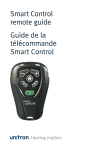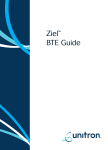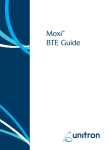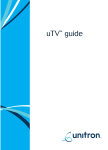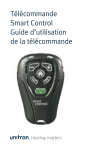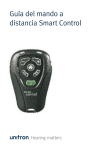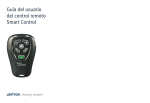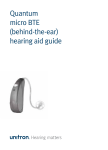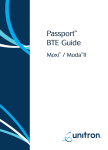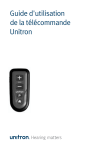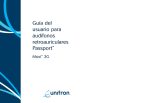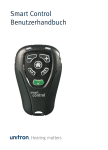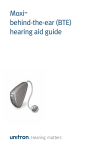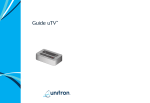Download Unitron Remote Control Operating instructions
Transcript
Smart Control remote guide Thank you Your Smart Control remote Thank you for choosing Unitron Smart Control remote for your Unitron hearing aids. Hearing healthcare professional: _______________ At Unitron, we care deeply about people with hearing loss. We work closely with hearing healthcare professionals to make advanced, purpose-driven solutions available to everyone. Because hearing matters. __________________________________________ Telephone: _________________________________ Model: ____________________________________ Serial number:______________________________ Replacement batteries: One AAA (1.5 Volt), Standard or Rechargeable Warranty: __________________________________ Date of purchase: ___________________________ Quick reference Table of contents Changing batteries 3 R 2 4 2 Your Smart Control at a glance ...............................................2 L R 6 1 7 8 L 5 1 Turning your Smart Control on and off....................................4 9 Replacing the battery ..............................................................5 10 11 Operating instructions.............................................................7 Adjusting your hearing aids with Smart Control.....................8 Scroll wheel ..........................................................................8 Battery size AAA Low battery Warning left and right indicator lights blink alternately for 2 minutes On/off R L Off On 1 2 3 4 5 6 7 8 On-off switch Left-both-right switch Left (blue) indicator light Right (red) indicator light Scroll wheel +/– buttons Home button Telephone (or program) button 9 Program change button 10 LearnNow™ button 11 Battery compartment Volume control .....................................................................9 Telephone button................................................................10 Program change button.......................................................11 LearnNow button ................................................................12 Home button.......................................................................13 Accessories ............................................................................14 Caring for your Smart Control................................................15 Cleaning your Smart Control .................................................16 Troubleshooting guide...........................................................17 Warnings ................................................................................18 Declaration of Conformity .....................................................22 Your Smart Control at a glance 3 1 On-off switch - turn your remote control on or off and also lock it to avoid sending unintentional commands 2 Left-both-right switch - allows you to select the hearing aid you want to adjust 3 Left (blue) indicator light - flashes to indicate your left hearing aid is being adjusted 2 4 6 1 7 8 5 9 10 4 Right (red) indicator light - flashes to indicate your right hearing aid is being adjusted 5 Scroll wheel* - allows you to manage the levels of speech and background noise in your hearing aids 6 Volume control buttons* - adjusts the volume of your hearing aids 2 7 Home button - returns your hearing aids to their startup program 8 Telephone (or program) button - switches the hearing aid to the telephone program R 5 L 1 9 Program change button - advances your hearing aid to their next listening program 10 LearnNow™ button - teaches your hearing aids your preferred settings in different listening programs 11 11 Battery compartment - allows access to change the battery 2 * Control may be customized by your hearing healthcare professional so that the functions of 5 and 6 may be swapped. 3 Turning your Smart Control on and off Replacing the battery Your Smart Control has an On-Off (or travel lock) switch on the left side of the remote. The battery compartment is located on the back of the Smart Control. To turn the remote control on, slide the switch into the On or unlocked position . 1. Slide the battery cover in the direction of the arrow. To turn the remote control off, slide the switch into the Off or locked position . Sliding the switch to the Off position will avoid sending unintentional commands to your hearing aids (while the remote is in your handbag or pocket, for example). R L Off On 4 2. Grasp the old battery with your thumb and index finger and remove. 3. Insert the new battery into the battery compartment in the correct +/- position, placing the battery’s minus (-) end into the compartment first. 4. Slide the battery cover in the opposite direction of the arrow. R L R L 5 Low battery warning Operating instructions When you see the left and right indicator lights blink alternating blue and red for two seconds, your Smart Control is warning you that the battery in your remote is low. You will see the warning every time you turn on your Smart Control or send a command to your hearing aids until you change the battery or the battery dies. Before using your Smart Control, turn on your hearing aids to ensure they are able to receive the Smart Control commands. Caring for batteries Always discard batteries in a safe and environmentally friendly way To prolong battery life, remember to turn the remote control off when not in use Smart Control is designed to be used comfortably in your hand at a maximum distance of one arm’s length. You do not have to point the remote at your hearing aids. Placing the remote control directly next to or too close to your hearing aids may decrease the remote’s effectiveness. Selecting which hearing aid to adjust At the top of the remote control, there is a Left-Both-Right switch. This switch allows you to select the hearing aids you want to adjust. L to R Slide the switch to the left position adjust your left hearing aid only. The left (blue) indicator light will flash to indicate your left hearing aid is being adjusted. Slide the switch to the right position 6 R to L 7 adjust your right hearing aid only. The right (red) indicator light will flash to indicate your right hearing aid is being adjusted. aids and provides an additional fine tuning adjustment beyond a traditional volume control. L Slide the switch to the center positionR to adjust both your hearing aids. Both indicator lights will flash to indicate your left and right hearing aids are being adjusted at once. Scroll the wheel up slowly to increase the clarity of sounds, such as speech. Adjusting your hearing aids with Smart Control As the wheel is adjusted, your hearing aids may beep. Please refer to your hearing aid guide for more information on your control feature. Your Smart Control provides backlighting when it is first turned on and each time a button is pressed, allowing you to see the remote buttons in dimly lit environments. Scroll the wheel down slowly to increase comfort in noisy listening situations. Volume control buttons Scroll wheel comfort-clarity setting (Available with Quantum™ 20 and 12, Moxi™ 20 and 12, Passport™, Latitude™ 16, Yuu™ L and Next™ 16Rhearing aids) The scroll wheel allows you to manage the levels of speech and background noise in your hearing 8 To increase the volume on your hearing aids, press the + button on your Smart Control. To decrease the volume on your hearing aids, press the – button on your Smart Control. As the volume is adjusted, your hearing aids 9 may beep. Please refer to your hearing aid guide for more information on your hearing aids’ volume beeps. Note: Your hearing healthcare professional may configure the scroll wheel as your volume control and your +/– buttons as your comfortclarity control. Telephone (or program) button To switch to the telephone program, press the Telephone button. The telephone button can also be set to provide you with direct access to another specified listening program that your hearing healthcare professional has selected for you. Talk to your hearing healthcare professional to find out how your telephone button has been configured. To exit the telephone program, press the Home button. 10 Telephone button with Binaural Phone (Binaural Phone exclusive to wireless styles of Quantum 20 and 12, Moxi 20 and 12 as well as Passport and Latitude 16 hearing aids) To switch to the Binaural Phone program, press the Telephone button once. This will allow you to hear the conversation through both hearing aids automatically. Press the Telephone button again, and this will allow you to hear the phone conversation in only one ear. To exit the Binaural Phone program, press the Home button. Program Change button To change the current listening program of your hearing aids, press the Program Change button. The hearing aid will advance to the next listening program. Please refer to your hearing aid guide to determine which programs are available to you and their program beep notifications. 11 LearnNow™ button (Available with Quantum 20, Moxi 20, Passport and Yuu hearing aids) The LearnNow™ button teaches your hearing aids the volume and comfortclarity settings you prefer in different listening environments. When you press the LearnNow button, Smart Control sends a command to your hearing aids to learn your current settings more quickly. By teaching your hearing aids you are personalizing your volume and comfort-clarity settings and minimizing the need for adjustments when you are in a similar listening environment in the future. Note: The LearnNow button should be pressed after you have adjusted the volume and/or comfort-clarity settings to your preferred levels. After pressing the LearnNow button, your hearing aids will beep if the command was successfully received. 12 Note: The LearnNow button on your Smart Control may be deactivated by your hearing healthcare professional and, therefore, could be inactive. Note: On Passport and Yuu the LearnNow button will only work when your hearing aids are set to the automatic program. Home button The Home button returns both of your hearing aids to their start-up program, similar to when you first turn on your hearing aids. This button can be useful when you want your hearing aids, regardless of the position of the Left-Both-Right switch, to return to the start-up program and the volume and comfort-clarity settings when your hearing aids are first turned on. Please refer to your hearing aid guide to determine which program is your start-up program. 13 Accessories Caring for your Smart Control Your Smart Control can be used with a lanyard so that you can carry the remote around your neck or wrist. Attach the lanyard to the remote, as illustrated below. Open the battery compartment and remove the battery if the remote control will not be used for long periods of time. 1. 2. 3. 4. Do not use your Smart Control in the bath or shower or immerse it in water. If your remote control does become wet, do not attempt to dry it in an oven or microwave. Do not adjust any controls. Open the battery compartment and remove the battery to allow your remote control to dry naturally for 24 hours. 5. 6. 7. Protect your remote control from excessive heat (hair dryer, vehicle glove box or dashboard). Do not drop your remote control or knock it against hard surfaces. 14 15 Cleaning your Smart Control Do not use alcohol to clean your remote control. Use a damp cloth to clean the outside of the remote. Troubleshooting guide Refer to the troubleshooting table below if you are having problems with your Smart Control. For problems with your hearing aids, please consult your hearing aid guide. Cause Possible remedy Indicator lights not flashing Turn on Not turned on Low/dead battery Replace battery Poor battery contact Consult your hearing healthcare professional Battery upside down Insert battery plus (+) side up Indicator lights flashing rapidly Replace battery Low battery Hearing aids not responding to Smart Control commands Move the remote control Holding the remote control too far away closer to you Holding the remote control too close 16 Move the remote to a maximum distance of one arm’s length For any problems not listed in the guide, contact your hearing healthcare professional. If you do not have a hearing healthcare professional, please contact the nearest office listed on the back page of this booklet. 17 Warnings Smart Control should only be used as directed by your hearing healthcare professional. Smart Control uses a low-power, digitally coded inductive transmission to communicate to your hearing aids. Although unlikely, interference with medical devices such as pacemakers is possible. Interference should not occur with normal use, holding the remote comfortably in the hand, 4 inches (10 centimeters) or more from the body. Therefore, it is recommended that pacemaker users do not keep the remote control in a breast pocket. Do not use Smart Control in explosion hazard areas. Do not use Smart Control in locations forbidden to use electronic devices, such as an airplane. 18 Store your Smart Control in a safe location for CT and MRI scans or for other electromagnetic procedures. Changes or modifications made to the Smart Control not expressly approved by Unitron Hearing may void the user’s authority to operate the equipment. Battery warnings Never leave your remote control or batteries where small children and pets can reach them. Never put your remote control or batteries in your mouth. If a battery is swallowed, call a physician immediately. Precautions If your Smart Control fails to operate after you have correctly inserted a new battery, contact your hearing healthcare professional. Always bring both your Smart Control, and your hearing aids for service questions. 19 Your Smart Control and your hearing aids are given a unique communication code. Because of this code, your Smart Control will not affect hearing aids worn by others. Your Smart Control uses the most modern components to provide an extremely reliable experience with virtually no interference from other devices. However, when operating the Smart Control near a computer terminal, communication device such as a digital cell phone, or other strong electromagnetic field, it may be necessary to be at least 24 inches (60 centimeters) away to ensure proper operation. If your hearing aids do not respond to the Smart Control because of an unusual field disturbance, move away from the disturbing field. 20 Labeling The serial number and year of manufacture are located inside the battery compartment. Please fill out the contact information sticker provided with your new Smart Control which is located inside the battery compartment. 21 Declaration of conformity Hereby, Unitron Hearing declares that Smart Control is in compliance with the essential requirements and other relevant provisions of Directive 93/42/EEC. To obtain a copy of the Declaration of Conformity, please contact your local representative from the list of Unitron Hearing Distributors. This device complies with part 15 of the FCC rules and with RSS 210 of Industry Canada. Operation is subject to the following two conditions: (1) This device does not cause harmful interference, and (2) this device must accept any interference received, including interference that may cause undesired operation. Guidance and manufacturer’s declaration - electromagnetic emissions The Model Smart Control is intended for use in the electromagnetic environment specified below. The customer or the user of the Model Smart Control should assure that it is used in such an environment. Emission test Compliance Electromagnetic environment guidance RF emissions CISPR 11 Group 2 The Model Smart Control must emit electromagnetic energy in order to perform its intended function. Nearby electronic equipment may be affected. RF emissions CISPR 11 Class B The Model Smart Control is suitable for use in all establishments, including domestic establishments and those directly connected to the public low-voltage power supply network that supplies buildings used for domestic purposes. Harmonic emissions IEC 61000-3-2 Not applicable Voltage fluctuations/ flicker emissions IEC 61000-3-3 Not applicable Table 201 22 23 Guidance and manufacturer’s declaration – electromagnetic immunity Guidance and manufacturer’s declaration – electromagnetic immunity The Model Smart Control is intended for use in the electromagnetic environment specified below. The customer or the user of the Model Smart Control should assure that it is used in such an environment. Immunity test Electrostatic discharge (ESD) IEC 60601 test level Compliance level Electrical fast transient/burst IEC 61000-4-4 Surge ±6 kV contact ±8 kV air Floors should be wood, concrete or ceramic tile. If floors are covered with synthetic material, the relative humidity should be at least 30%. ±2 kV for power supply lines ±1 kV for input/output lines Not applicable Mains power quality should be that of a typical commercial or hospital environment. ±1 kV line(s) to line(s) ±2 kV line(s) to earth Not applicable Mains power quality should be that of a typical commercial or hospital environment. IEC 61000-4-5 Voltage dips, short interruptions and voltage variations on power supply input lines <5% UT (>95% dip in UT) Not applicable for 0,5 cycle 40% UT (60% dip in UT) for 5 cycles 70% UT (30% dip in UT) for 25 cycle IEC 61000-4-11 <5% UT (>95% dip in UT) for 5 sec Power frequency (50/60 Hz) magnetic field Electromagnetic environment - guidance ±6 kV contact ±8 kV air IEC 61000-4-2 3 A/m 3 A/m IEC 61000-4-8 Mains power quality should be that of a typical commercial or hospital environment. If the user of the Model Smart Control requires continued operation during power mains interruptions, it is recommended that the Model Smart Control be powered from an uninterruptible power supply or a battery. Power frequency magnetic fields should be at levels characteristic of a typical location in a typical commercial or hospital environment. NOTE: UT is the a.c. mains voltage prior to application of the test level. 24 Table 202 The Model Smart Control is intended for use in the electromagnetic environment specified below. The customer or the user of the Model Smart Control should assure that it is used in such an environment. Immunity test IEC 60601 Compliance Electromagnetic environment - guidance test level level Portable and mobile RF communications equipment should be used no closer to any part of Smart Control, including cables, than the recommended separation distance calculated from the equation applicable to the frequency of the transmitter. Recommended separation distance Conducted RF IEC 61000-4-6 3 Vrms 150 kHz to 80 MHz Not applicable d = 1,2 Radiated RF IEC 61000-4-3 3 V/m 80 MHz to 2,5 GHz 3 V/m d = 1,2 80 MHz to 800 MHz d = 2,3 800 MHz to 2,5 GHz where P is the maximum output power rating of the transmitter in watts (W) according to the transmitter manufacturer and d is the recommended separation distance in meters (m). Field strengths from fixed RF transmitters, as determined by an electromagnetic site survey,a should be less than the compliance level in each frequency rangeb. Interference may occur in the vicinity of equipment marked with the following symbol: NOTE 1: At 80 MHz and 800 MHz, the higher frequency range applies. NOTE 2: These guidelines may not apply in all situations. Electromagnetic propagation is affected by absorption and reflection from structures, objects and people. a Field strengths from fixed transmitters, such as base stations for radio (cellular/cordless) telephones and land mobile radios, amateur radio, AM and FM radio broadcast and TV broadcast cannot be predicted theoretically with accuracy. To assess the electromagnetic environment due to fixed RF transmitters, an electromagnetic site survey should be considered. If the measured field strength in the location in which the Model Smart Control is used exceeds the applicable RF compliance level above, the Model Smart Control should be observed to verify normal operation. If abnormal performance is observed, additional measures may be necessary, such as re-orienting or relocating the Model Smart Control. b Over the frequency range 150 kHz to 80 MHz, field strengths should be less than 3 V/m. Table 204 Recommended separation distances between portable and mobile RF communications equipment and the Model Smart Control The Model Smart Control is intended for use in an electromagnetic environment in which radiated RF Disturbances are controlled. The customer or the user of the Model Smart Control can help prevent electromagnetic interference by maintaining a minimum distance between portable and mobile RF communications equipment (transmitters) and the Model Smart Control as recommended below, according to the maximum output power of the communications equipment. Rated maximum output power of transmitter W Separation Distance according to frequency of transmitter m 150 kHz to 80 MHz d = 1,2 80 MHz to 800 MHz d = 1,2 800 MHz to 2,5 GHz d = 2,3 0.01 0.12 0.12 0.23 0.1 0.38 0.38 0.73 1 1.2 1.2 2.3 10 3.8 3.8 7.3 100 12 12 23 For transmitters rated at a maximum output power not listed above, the recommended separation distance d in meters (m) can be estimated using the equation applicable to the frequency of the transmitter, where P is the maximum output power rating of the transmitter in watts (W) according to the transmitter manufacturer. NOTE 1: At 80 MHz and 800 MHz, the higher frequency range applies. NOTE 2: These guidelines may not apply in all situations. Electromagnetic propagation is affected by absorption and reflection from structures, objects and people. Table 206 26 Unitron distributors Corporate Office/International 20 Beasley Drive, P.O. Box 9017, Kitchener, ON N2G 4X1 Canada Australia Level 2, Norwest Quay, 21 Solent Circuit, Baulkham Hills, NSW, NSW 2153 Belgium Baron de Vironlaan, 60 b-1700 Dilbeek Canada 20 Beasley Drive, P.O. Box 9017, Kitchener, ON N2G 4X1 China No. 78, Qi Ming Road, Export Processing Zone District B, Suzhou Industrial Park, P.R. 215021 Denmark Nitivej 10, DK-2000 Frederiksberg Germany & European Representative Daimlerstrasse 22, 70736 FellbachOeffingen, Germany France 5 bis, rue Maryse Bastié - BP 15 69671 Bron Cedex India B-308, Everest Grande, Mahakali Caves Road, Andheri East, Mumbai-400 093 Spain Avenida de la Industria nº13/15, Polígono de Canastell, 03690 Sant Vicent del Raspeig. Alicante, España Sweden Förmansvägen 2, 4 tr SE-11743, Stockholm Netherlands Ir. D.S. Tuijnmanweg 10, United Kingdom 4131 PN St. George House, VIANEN Cygnet Court, New Zealand Centre Park, 10/215 Rosedale Rd., Warrington, Cheshire M277 Private Bag, WA1 1PD 300987, Albany, U.S.A. Auckland Suite A, 2300 Russia Berkshire Lane North, Tverskaya str. 16, Plymouth, MN 55441 bldg. 3, 1st floor Moscow, 125009 South Africa First Floor – Selborne House, Fourways Golf Park, Roos Street, Fourways, Johannesburg Unitron Hearing Ltd. 20 Beasley Drive, P.O. Box 9017, Kitchener, ON N2G 4X1 Canada Distributor www.unitron.com K/10-047 029-5644-02

















